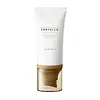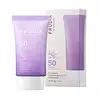What's inside
What's inside
 Key Ingredients
Key Ingredients

 Benefits
Benefits

 Concerns
Concerns

 Ingredients Side-by-side
Ingredients Side-by-side

Water
Skin ConditioningZinc Oxide
Cosmetic ColorantPropanediol
SolventDicaprylyl Carbonate
EmollientButylene Glycol
HumectantCaprylic/Capric Triglyceride
MaskingBenzotriazolyl Dodecyl P-Cresol
UV AbsorberCentella Asiatica Extract
CleansingPolyglyceryl-3 Distearate
EmulsifyingNiacinamide
SmoothingCaprylyl Methicone
Skin ConditioningC12-15 Alkyl Benzoate
Antimicrobial1,2-Hexanediol
Skin ConditioningPentylene Glycol
Skin ConditioningCetearyl Alcohol
EmollientPortulaca Oleracea Extract
Skin ConditioningHouttuynia Cordata Extract
Skin ConditioningPolyhydroxystearic Acid
EmulsifyingGlyceryl Stearate
EmollientHydrolyzed Jojoba Esters
Skin ConditioningSodium Polyacryloyldimethyl Taurate
Emulsion StabilisingTriethoxycaprylylsilane
Glyceryl Stearate Citrate
EmollientPolyacrylate Crosspolymer-6
Emulsion StabilisingMethylpropanediol
SolventEthylhexylglycerin
Skin ConditioningXanthan Gum
EmulsifyingAdenosine
Skin ConditioningPolyether-1
T-Butyl Alcohol
PerfumingBiosaccharide Gum-1
HumectantMadecassic Acid
Skin ConditioningAsiaticoside
AntioxidantAsiatic Acid
Skin ConditioningWater, Zinc Oxide, Propanediol, Dicaprylyl Carbonate, Butylene Glycol, Caprylic/Capric Triglyceride, Benzotriazolyl Dodecyl P-Cresol, Centella Asiatica Extract, Polyglyceryl-3 Distearate, Niacinamide, Caprylyl Methicone, C12-15 Alkyl Benzoate, 1,2-Hexanediol, Pentylene Glycol, Cetearyl Alcohol, Portulaca Oleracea Extract, Houttuynia Cordata Extract, Polyhydroxystearic Acid, Glyceryl Stearate, Hydrolyzed Jojoba Esters, Sodium Polyacryloyldimethyl Taurate, Triethoxycaprylylsilane, Glyceryl Stearate Citrate, Polyacrylate Crosspolymer-6, Methylpropanediol, Ethylhexylglycerin, Xanthan Gum, Adenosine, Polyether-1, T-Butyl Alcohol, Biosaccharide Gum-1, Madecassic Acid, Asiaticoside, Asiatic Acid
Water
Skin ConditioningOctocrylene
UV AbsorberHomosalate
Skin ConditioningEthylhexyl Salicylate
UV AbsorberButyl Methoxydibenzoylmethane
UV AbsorberButyloctyl Salicylate
Skin ConditioningNiacinamide
SmoothingDicaprylyl Carbonate
EmollientDipropylene Glycol
HumectantCetearyl Alcohol
EmollientCetearyl Glucoside
EmulsifyingPoly C10-30 Alkyl Acrylate
Emulsion StabilisingSorbitan Olivate
EmulsifyingPolymethylsilsesquioxane
Vaccinium Angustifolium Fruit Extract
Skin ProtectingBenzyl Glycol
SolventGlyceryl Stearate Se
EmulsifyingPanthenol
Skin ConditioningCarbomer
Emulsion StabilisingArginine
MaskingTocopheryl Acetate
AntioxidantGlycerin
HumectantGlyceryl Glucoside
HumectantEthylhexylglycerin
Skin ConditioningXanthan Gum
EmulsifyingHydroxypropyl Methylcellulose Stearoxy Ether
Disodium EDTA
Parfum
MaskingAdenosine
Skin ConditioningPropanediol
SolventCaprylic/Capric Triglyceride
MaskingPentylene Glycol
Skin ConditioningSodium Hyaluronate Crosspolymer
HumectantHydrolyzed Glycosaminoglycans
HumectantHydrogenated Lecithin
Emulsifying1,2-Hexanediol
Skin ConditioningSodium Hyaluronate
HumectantTocopherol
AntioxidantGanoderma Lucidum Stem Extract
Skin ConditioningHydrolyzed Hyaluronic Acid
HumectantPhytosterols
Skin ConditioningHyaluronic Acid
HumectantWater, Octocrylene, Homosalate, Ethylhexyl Salicylate, Butyl Methoxydibenzoylmethane, Butyloctyl Salicylate, Niacinamide, Dicaprylyl Carbonate, Dipropylene Glycol, Cetearyl Alcohol, Cetearyl Glucoside, Poly C10-30 Alkyl Acrylate, Sorbitan Olivate, Polymethylsilsesquioxane, Vaccinium Angustifolium Fruit Extract, Benzyl Glycol, Glyceryl Stearate Se, Panthenol, Carbomer, Arginine, Tocopheryl Acetate, Glycerin, Glyceryl Glucoside, Ethylhexylglycerin, Xanthan Gum, Hydroxypropyl Methylcellulose Stearoxy Ether, Disodium EDTA, Parfum, Adenosine, Propanediol, Caprylic/Capric Triglyceride, Pentylene Glycol, Sodium Hyaluronate Crosspolymer, Hydrolyzed Glycosaminoglycans, Hydrogenated Lecithin, 1,2-Hexanediol, Sodium Hyaluronate, Tocopherol, Ganoderma Lucidum Stem Extract, Hydrolyzed Hyaluronic Acid, Phytosterols, Hyaluronic Acid
 Reviews
Reviews

Ingredients Explained
These ingredients are found in both products.
Ingredients higher up in an ingredient list are typically present in a larger amount.
1,2-Hexanediol is a synthetic liquid and another multi-functional powerhouse.
It is a:
- Humectant, drawing moisture into the skin
- Emollient, helping to soften skin
- Solvent, dispersing and stabilizing formulas
- Preservative booster, enhancing the antimicrobial activity of other preservatives
Adenosine is in every living organism. It is one of four components in nucleic acids that helps store our DNA.
Adenosine has many benefits when used. These benefits include hydrating the skin, smoothing skin, and reducing wrinkles. Once applied, adenosine increases collagen production. It also helps with improving firmness and tissue repair.
Studies have found adenosine may also help with wound healing.
In skincare products, Adenosine is usually derived from yeast.
Learn more about AdenosineThis ingredient is an emollient, solvent, and texture enhancer. It is considered a skin-softener by helping the skin prevent moisture loss.
It helps thicken a product's formula and makes it easier to spread by dissolving clumping compounds.
Caprylic Triglyceride is made by combining glycerin with coconut oil, forming a clear liquid.
While there is an assumption Caprylic Triglyceride can clog pores due to it being derived from coconut oil, there is no research supporting this.
Learn more about Caprylic/Capric TriglycerideCetearyl alcohol is a mixture of two fatty alcohols: cetyl alcohol and stearyl alcohol. It is mainly used as an emulsifier. Emulsifiers help prevent the separation of oils and products. Due to its composition, it can also be used to thicken a product or help create foam.
Cetearyl alcohol is an emollient. Emollients help soothe and hydrate the skin by trapping moisture.
Studies show Cetearyl alcohol is non-toxic and non-irritating. The FDA allows products labeled "alcohol-free" to have fatty alcohols.
This ingredient is usually derived from plant oils such as palm, vegetable, or coconut oils. There is debate on whether this ingredient will cause acne.
Due to the fatty acid base, this ingredient may not be Malassezia folliculitis safe.
Learn more about Cetearyl AlcoholDicaprylyl Carbonate comes from carbonic acid and caprylyl alcohol, a fatty alcohol. It is an emollient and gives skin a velvet feel. The sources of Dicaprylyl Carbonate may be synthetic or from animals.
As an emollient, Dicaprylyl Carbonate creates a film on the skin. This film traps moisture in, keeping your skin soft and hydrated.
Ethylhexylglycerin (we can't pronounce this either) is commonly used as a preservative and skin softener. It is derived from glyceryl.
You might see Ethylhexylglycerin often paired with other preservatives such as phenoxyethanol. Ethylhexylglycerin has been found to increase the effectiveness of these other preservatives.
Niacinamide is a multitasking form of vitamin B3 that strengthens the skin barrier, reduces pores and dark spots, regulates oil, and improves signs of aging.
And the best part? It's gentle and well-tolerated by most skin types, including sensitive and reactive skin.
You might have heard of "niacin flush", or the reddening of skin that causes itchiness. Niacinamide has not been found to cause this.
In very rare cases, some individuals may not be able to tolerate niacinamide at all or experience an allergic reaction to it.
If you are experiencing flaking, irritation, and dryness with this ingredient, be sure to double check all your products as this ingredient can be found in all categories of skincare.
When incorporating niacinamide into your routine, look out for concentration amounts. Typically, 5% niacinamide provides benefits such as fading dark spots. However, if you have sensitive skin, it is better to begin with a smaller concentration.
When you apply niacinamide to your skin, your body converts it into nicotinamide adenine dinucleotide (NAD). NAD is an essential coenzyme that is already found in your cells as "fuel" and powers countless biological processes.
In your skin, NAD helps repair cell damage, produce new healthy cells, support collagen production, strengthen the skin barrier, and fight environmental stressors (like UV and pollution).
Our natural NAD levels start to decline with age, leading to slower skin repair, visible aging, and a weaker skin barrier. By providing your skin niacinamide, you're recharging your skin's NAD levels. This leads to stronger, healthier, and younger looking skin.
Another name for vitamin B3 is nicotinamide. This vitamin is water-soluble and our bodies don't store it. We obtain Vitamin B3 from either food or skincare. Meat, fish, wheat, yeast, and leafy greens contain vitamin B3.
The type of niacinamide used in skincare is synthetically created.
Learn more about NiacinamidePentylene glycol is typically used within a product to thicken it. It also adds a smooth, soft, and moisturizing feel to the product. It is naturally found in plants such as sugar beets.
The hydrophilic trait of Pentylene Glycol makes it a humectant. As a humectant, Pentylene Glycol helps draw moisture from the air to your skin. This can help keep your skin hydrated.
This property also makes Pentylene Glycol a great texture enhancer. It can also help thicken or stabilize a product.
Pentylene Glycol also acts as a mild preservative and helps to keep a product microbe-free.
Some people may experience mild eye and skin irritation from Pentylene Glycol. We always recommend speaking with a professional about using this ingredient in your routine.
Pentylene Glycol has a low molecular weight and is part of the 1,2-glycol family.
Learn more about Pentylene GlycolPropanediol is an all-star ingredient. It softens, hydrates, and smooths the skin.
It’s often used to:
Propanediol is not likely to cause sensitivity and considered safe to use. It is derived from corn or petroleum with a clear color and no scent.
Learn more about PropanediolWater. It's the most common cosmetic ingredient of all. You'll usually see it at the top of ingredient lists, meaning that it makes up the largest part of the product.
So why is it so popular? Water most often acts as a solvent - this means that it helps dissolve other ingredients into the formulation.
You'll also recognize water as that liquid we all need to stay alive. If you see this, drink a glass of water. Stay hydrated!
Learn more about WaterXanthan gum is used as a stabilizer and thickener within cosmetic products. It helps give products a sticky, thick feeling - preventing them from being too runny.
On the technical side of things, xanthan gum is a polysaccharide - a combination consisting of multiple sugar molecules bonded together.
Xanthan gum is a pretty common and great ingredient. It is a natural, non-toxic, non-irritating ingredient that is also commonly used in food products.
Learn more about Xanthan Gum